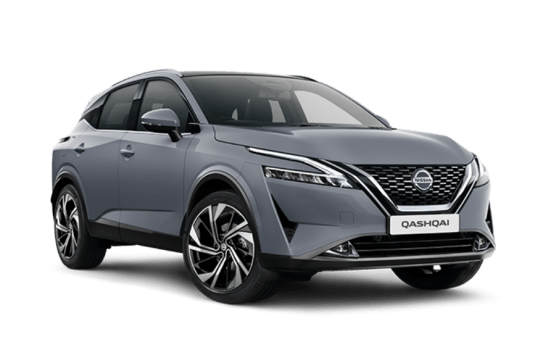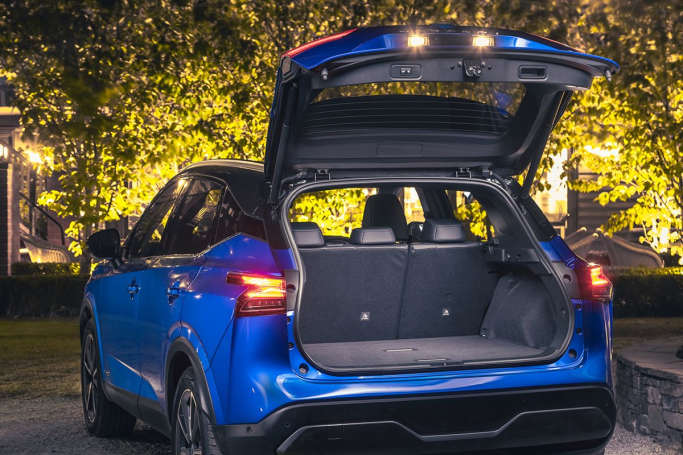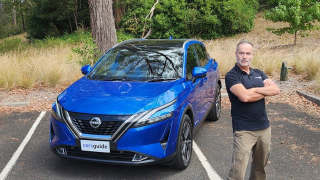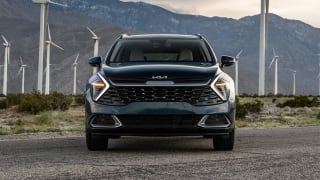
What's on this page
Nissan Qashqai 2024
Carsguide Contributing Journalist Byron Mathioudakis had this to say at the time: So, should you give up on the Qashqai e-Power, or surrender to its many and varied charms? Well, when the Japanese brand really tries, as it clearly has here, Nissan can be as imaginative and as innovative as any carmaker on the planet.
You can read the full review here.This is what Byron Mathioudakis liked most about this particular version of the Nissan Qashqai: Attractive design inside and out, Strong yet frugal performance, Quality presentation
The Nissan Qashqai SUV competes with similar models like the Toyota RAV4, Kia Sportage and Subaru Forester in the Under $40k category category.
The 2024 Nissan Qashqai carries a braked towing capacity of up to 1500 Kg, but check to ensure this applies to the configuration you're considering.
The Nissan Qashqai is also known as the Nissan Dualis (Japan and Australia, the 1st gen.), the Nissan Rogue Sport (United States and the 2nd gen.) in markets outside Australia.
Nissan Qashqai 2024 Price and Specs
Pricing guides

| Nissan Qashqai Model | Body Type | Specs | Price | |
|---|---|---|---|---|
| ST | SUV | 1.3L — CVT AUTO | $33,890 | |
| ST+ | SUV | 1.3L — CVT AUTO | $37,890 | |
| ST+ 2-Tone | SUV | 1.3L — CVT AUTO | $38,390 | |
| ST-L | SUV | 1.3L — CVT AUTO | $42,190 | |
Nissan Qashqai 2024 Colours
The Qashqai is available in the following colours: 'Gun Metallic', 'Ceramic Grey', 'Platinum', 'Burgundy', 'Fuji Sunset Red', 'Ivory Pearl', 'Magnetic Blue' and 'Pearl Black'.
- Gun Metallic
- Ceramic Grey
- Platinum
- Burgundy
- Fuji Sunset Red
- Ivory Pearl
- Magnetic Blue
- Pearl Black
Nissan Qashqai 2024 Boot Space
Nissan says the Qashqai's cargo capacity varies according to spare-wheel fitment. This means the higher-wheeled Ti version offers 418 litres, whilst the smaller-wheeled ST, ST+ and ST-L models boast 429L. However, losing the spare wheel altogether for a tyre-inflation kit means the Ti e-Power bumps that figure up to 452L and – if you lower the back seat – to 1518L, compared to the others’ 1513L.

Nissan Qashqai 2024 Interior
The Qashqai’s interior is larger and more spacious than in previous generations, thanks to a handy 19mm wheelbase stretch. Doors open very wide, revealing a cosy yet roomy layout dominated by a modern and attractive dashboard layout. It features a centrally-mounted touchscreen as well as an electronic display ahead of the driver. Some models also score a head-up display reflected on the windscreen.
A good driving position, excellent access to all controls, ample ventilation and lots of storage are further Qashqai interior highlights. However, rear vision is limited due to shallow side windows and thick pillars. The rear seat area has all expected amenities across the range, including ventilation and USB A and C outlets. Some models also feature a folding centre armrest with cupholders.

Nissan Qashqai 2024 Q&As
Check out real-world situations relating to the Nissan Qashqai here, particularly what our experts have to say about them.
-
What's a good hybrid car to buy?
The default purchase for somebody looking for a mid-sized hybrid SUV is the Toyota RAV4 Hybrid. But if that’s too big, there’s the Toyota Yaris Cross Hybrid, C-HR Hybrid and even the Corolla Cross Hybrid which sounds like the marketplace is getting crowded but is really just a reflection of the appetite right now for cars like these. And that’s the catch; the waiting times for a brand-new example of some of these cars is out to many months and even years. So your plan to shop second-hand makes plenty of sense, but don’t expect any bargains in a market currently being dominated by lots of demand and less supply.
Beyond the Toyota brand (which has been doing hybrids longer than just about anybody else) there’s also the Mazda CX-30, Subaru XV Hybrid, Haval Jolion Hybrid, Kia Niro, Subaru Forester Hybrid, Nissan Qashqai e-Power, MG HS, Honda HR-V e and more. For something a bit bigger, try the Kia Sorento or Hyundai Santa Fe hybrids. There are others out there, too, that are probably bigger or more expensive than you need, but it's very much a growing scene in the Australian marketplace.
Show more -
My Nissan Qashqai has been serviced but a systems warning fault is still coming up on my screen.
It’s important to give Nissan (or any other manufacturer) the opportunity to put things right. While ever that process is ongoing, you need to be patient and allow Nissan to try to find a fix. Your car is still covered by the manufacturer’s new-car warranty, so that’s the process by which it should be tackled.
If Nissan were to give up on the problem (and you) then you’d have cause to seek recourse according to Australian Consumer Law. I’d also be talking to Nissan Australia’s customer service division to see what else can be done.
Show more -
Why does my 2014 Nissan Qashqai shake when climbing an incline?
It sounds as though the vibration you’re experiencing is coming from the driveline. Perhaps it’s the engine but more likely it’s something in the transmission since the problem is worse when the car changes gear. That the problem occurs when climbing a grade suggests that it’s related to the engine being under load at which point the whole driveline – gearbox and driveshafts – are also loaded up.
It could be something within the transmission itself, a bent driveshaft or even something relatively simple like a worn CV joint. Carefully, and when it’s safe to do so, find a big, open area like a deserted car-park, turn the steering wheel all the way to the left and drive slowly in a tight circle. Now do the same on full right-hand lock. Can you hear any clinking or clunking noises? If you can, you have worn CV joints. If not, you need to dig deeper into the cause and that will require getting the car on a hoist and inspecting the driveline.
Show more -
How do I replace the blinker globe on my 2018 Nissan Qashqai?
If it’s the front indicator globe that’s blown, you need to open the bonnet and work from inside the engine bay. The front indicator globe is held in a plastic component that forms part of the whole headlight assembly. The bit you need to find is right at the outer edge of the headlight assembly, right in the corner of the engine bay. Once you’ve located that (it will have wires coming out of it), a half clockwise twist will allow you to remove the plastic globe holder and change the globe.
If it’s a rear globe, you need to open the hatchback, remove the screws that secure the tail-light assembly and then slide the tail-light free of the car. Turning it over, you’ll see the wiring and some plastic clips that fasten the globe-holder to the whole assembly. By unclipping this holder, you can remove it from the rest of the tail-light and reveal the globes which can then be removed and replaced.
Show more
Nissan Qashqai VS the competition
Nissan Qashqai 2024 Dimensions
Dimensions for the 2024 Nissan Qashqai are dependent on which body type is chosen. The maximum width and height is 1835mm x 1625mm and can vary on the basis of model.


| Nissan Qashqai Model | Body Type | Height x Width x Length | Ground Clearance | |
|---|---|---|---|---|
| ST | SUV | 1625x1835x4425 mm | 180 mm | |
| ST+ | SUV | 1625x1835x4425 mm | 180 mm | |
| ST+ 2-Tone | SUV | 1625x1835x4425 mm | 180 mm | |
| ST-L | SUV | 1625x1835x4425 mm | 180 mm | |
Nissan Qashqai 2024 Accessories
All Qashqais include LED headlights, keyless entry/start, Autonomous Emergency Braking (AEB), adaptive cruise control, a reverse camera, USB-C outlets front and rear, electronic instrumentation, a wireless phone charger, voice-control, Bluetooth connectivity, a centre touchscreen, wireless Apple CarPlay, wired Android Auto, rear parking sensors, rear air vents and alloy wheels.

Nissan Qashqai 2024 Fuel consumption
Fuel consumption for the 2024 Nissan Qashqai is dependent on the type of engine, transmission, or model chosen. The Nissan Qashqai currently offers fuel consumption from 5.2 to 6.1L/100km. The Nissan Qashqai is available with the following fuel types: — and Electric/pulp.
| Nissan Qashqai Model | Body Type | Specs | Fuel Consumption | |
|---|---|---|---|---|
| ST | SUV | 1.3L,—,CVT AUTO | 6.1L/100km | |
| ST+ | SUV | 1.3L,—,CVT AUTO | 6.1L/100km | |
| TI E-Power (hybrid) | SUV | 1.5L,Electric/pulp,1 SP AUTO | 5.2L/100km | |
| TI E-Power 2-Tone (hybrid) | SUV | 1.5L,Electric/pulp,1 SP AUTO | 5.2L/100km | |
Nissan Qashqai 2024 Towing capacity
The Nissan Qashqai’s towing capacity ranges from 750kg to 1500kg. Some models also offer heavy-duty or towing option packs which can increase towing capacity, as well as options which can hamper towing capacity. Towing capacities can vary wildly on a large number of factors. These include engine, transmission, model, and options chosen. Always check with the manufacturer or in your vehicles handbook before attempting to tow anything.
| Nissan Qashqai Model | Body Type | Specs | Braked Capacity | |
|---|---|---|---|---|
| ST | SUV | 1.3L,—,CVT AUTO | 1500kg | |
| ST+ | SUV | 1.3L,—,CVT AUTO | 1500kg | |
| ST+ 2-Tone | SUV | 1.3L,—,CVT AUTO | 1500kg | |
| ST-L | SUV | 1.3L,—,CVT AUTO | 1500kg | |
Nissan Qashqai 2024 Seats
The Qashqai’s front seats are well bolstered, providing good support at speed through tight corners. Higher grades swap out the manual reclining adjustment for electrical assistance, whilst the top model also includes massaging functionality. The 30/70 split-fold rear bench seats three, is fixed and thus does not recline or slide, as per some SUVs and crossovers. It does include a centre armrest with cupholders in higher-spec versions. A trio of child-seat tether latches are fitted, along with ISOFIX latches in the outboard positions.

Nissan Qashqai 2024 Wheel size
Wheel size for the 2024 Nissan Qashqai will vary depending on model chosen, although keep in mind that many manufacturers offer alternate wheel sizes as options on many models.The wheel size available will alter the range of tyres available to be fitted.
| Nissan Qashqai Model | Body Type | Front Tyre Size | Front Rim | Rear Tyre Size | Rear Rim | |
|---|---|---|---|---|---|---|
| ST | SUV | 215x65 R17 | — | 215x65 R17 | — | |
| ST+ | SUV | 235x55 R18 | — | 235x55 R18 | — | |
| ST+ 2-Tone | SUV | 235x55 R18 | — | 235x55 R18 | — | |
| ST-L | SUV | 235x50 R19 | — | 235x50 R19 | — | |
Nissan Qashqai 2024 Engine
The regular petrol-powered Qashqai uses a 1.3-litre four-cylinder turbo-petrol making 110kW/250Nm. It drives the front wheels via a continuously variable transmission known as a CVT.
Under the e-Power’s bonnet is a 1.5-litre three-cylinder turbo-petrol engine, producing 116kW of power and 250Nm of torque on its own. It is paired to a small-ish 2.1kWh lithium-ion battery and inverter, powering an electric motor that sends drive via a single-speed reduction-gear transmission to the front wheels. Combined power and torque maximums are 140kW and 330Nm, respectively.

Nissan Qashqai 2024 Speed
The Qashqai e-Power can accelerate from standstill to 100km/h (0-100km/h) in around 7.9 seconds, which is about half a second quicker than the regular 1.3-litre turbo petrol’s 8.4s result, on the way to a top speed of about 170km/h (versus the latter’s 206km/h).
Nissan Qashqai 2024 Range
The normal Qashqai with the 1.3L turbo petrol engine averages 6.1 litres per 100km on the combined cycle, which matches to a carbon dioxide emissions rating of 138 grams/km. Switching to the e-Power version, these figures tumble to 5.2L/100km and 117g/km respectively. Even with a 55L fuel tank, that means about 900 and 1050km between refills, respectively, though keep in mind both powertrains require 95 RON premium unleaded petrol.




